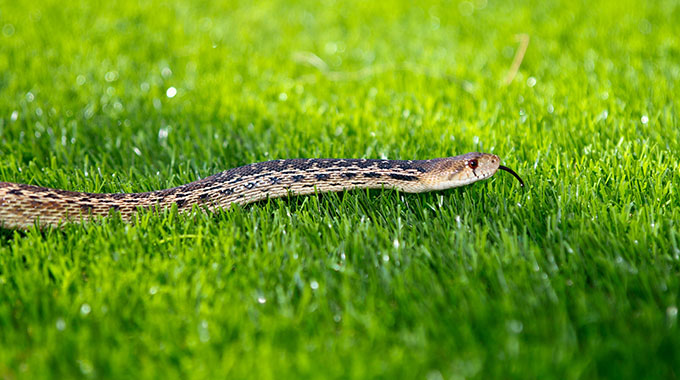
The Sunday Mail

Tinashe Farawo
Parks Analysis
EIGHT were killed by snakes in Zimbabwe last year, up from four who were killed the previous year.
Dozens more were injured, while the majority of cases go unreported.
Zimbabwe, which is generally considered a snake country, is now in the snake season.
Puff adders, spitting cobras and black mambas, which are all considered very dangerous to people and livestock, generally top the list of the most problematic snakes in Zimbabwe.
An average three sightings of python snakes are reported countrywide every week.
Pythons are considerably troublesome and are seen as more of a threat to livestock than humans.
They are facing extinction and are specially protected by law.
Zimbabwe is home to 80 different snake species, 20 of which are considered very dangerous.
Six species which are considered very dangerous account for 75 percent of the fatal snake bites in the country.
These are, the black mamba, snouted cobra, Mozambique spitting cobra, puff adder, boomslang and the Gaboon viper.
Between April and August, the reptiles’ brumation period, snakes are in a lethargic state as they go through hibernation.
However, during this period, the snake is still omnipotent when confronted.
Though snakes are cold blooded and highly dependent on their environment for body temperature regulation, they are just as alert during hibernation as they are in the summer.
From September through to March, snakes usually move a lot in search of food.
During this time, they will be increasing their body weight in preparation for the winter season when they are sustained by body fat and water as they lay dormant.
While snakes appear ruthless, they are docile creatures that slither away when encountered.
However, when confronted they turn the tables and expose their vicious side by bulging of the neck area or making a huffing and puffing sound to show discomfort.
At this point the snake will stand its ground.
These are the early signs showing that the snake is about to attempt a bite.
If the aggravation continues, it executes a vicious attack and on interaction the snake will envenomate (poison by biting).
Home invasions
One of the major causes of human-wildlife conflict at the onset of the rainy season is loss of habitat and food scarcity.
As a result, animals, including snakes, move into human communities in search of food and water.
Most snakes usually end up choosing the most expedient option for refuge – human homesteads.
Upon arrival in a homestead, the snake establishes its haven, in most cases, one where rodents are in abundance.
Then the demand for food, water and shelter will have been met.
Most snake diets consist of rats because they are easy prey and fast breeders.
Poor waste management in homes attracts rodents, which then breed and nest in the homestead.
The whiff of rodent odour inside the house is carried by the wind to passing snakes.
The snake will lurk around and finds its way inside only to stumble upon abundance.
It then establishes its territory usually under a pile of dirt and rubble.
Out of 20 snake species, which are considered dangerous, only two have binocular vision.
This means they can differentiate between a human being and any other obstacle.
The rest of the snakes have a monocular vision, meaning they identify objects based on motion.
Pythons also have heat pits that allow them to locate objects and estimate distance using the objects body temperature.
Avoiding harm
When confronted by a snake, it is very important to avoid rapid movements and to try to stay stationary.
If the snake stands its ground keep your eyes on it and slowly withdraw, usually the snake will also slither away.
Avoid throwing sticks, stones or any objects because this will result in the snake adopting a defensive posture and attack because it will feel threatened.
It is also important to avoid having thick bushy plants lined along the homestead’s wall because this provides a convenient pathway to shelter for the snakes.
Communities must also avoid having piles of rubble stacked around.
These rubble piles provide a good habitat for snakes because of minimal temperature fluctuations.
During the rainy season, it is important to keep doors closed because snakes looking for dry and warm places to rest can enter inside the house unnoticed.
In addition, the back of the fridge also provides a good source of heat.
There is also a need to dispose litter properly to avoid attracting rats.
Puff adders are found throughout Zimbabwe but are not found in forested areas and grasslands at high altitude.
During the day, puff adders usually bask in the sun or lay in ambush on a rodent trail.
They are however, mostly active during the night.
Gabon vipers are found in high rainfall zones along the eastern border areas.
They are most commonly found in Rusitu valley at the southern end of the Chimanimani mountains, north of Mutare, Honde and Pungwe valleys.
During the day they bask in patches of sunlight with their bodies partially buried in dried leaves.
Boomslang are common throughout Zimbabwe especially in areas below an altitude of 1 600m and are mostly found along streams where they hunt for frogs.
Tinashe Farawo is the head of communications at the Zimbabwe Parks and Wildlife Management Authority. He can be contacted on [email protected]



